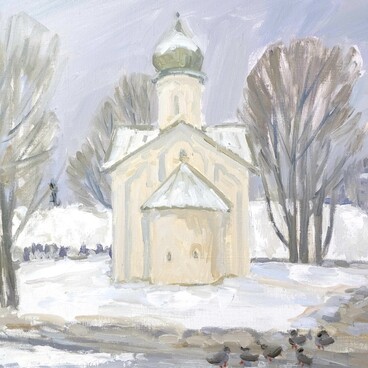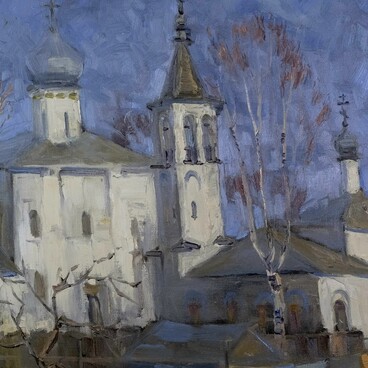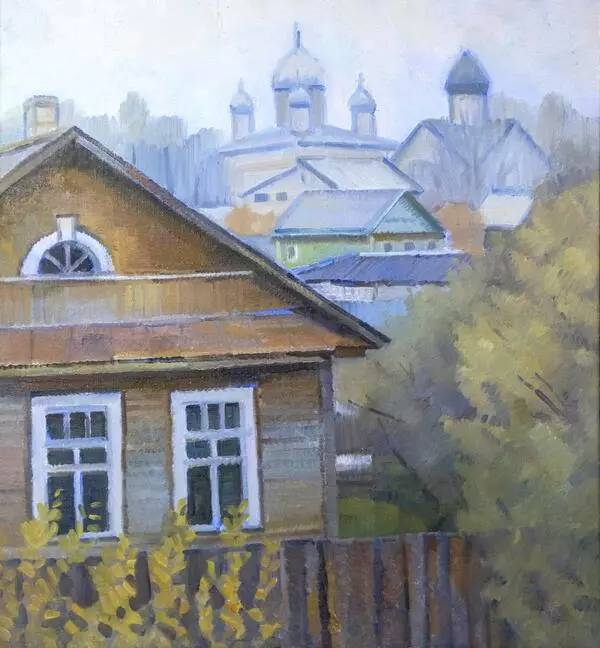Natalia Viktorovna Zakharova was born in the village of Tesovo-Netylsky. In 1973, she graduated from the Alexander Herzen Pedagogical Institute as a graphic artist and settled in Novgorod. Working in the “Academic Dacha” Art Centre, she met many artists. Natalia Viktorovna has been a member of the Artists’ Union since 1987, and has been teaching at the Yaroslav-the-Wise Novgorod State University since 1994. The artist has taken part in solo and group exhibitions in Russia and abroad: in Bulgaria, Sweden, Poland, and Lithuania.
This painting by Natalia Zakharova presents the now-inactive Desyatinny Convent.
In chronicles, the monastery was first mentioned in connection with the year 1327 when the construction of the Church of the Nativity of the Blessed Virgin Mary — the main church of the monastery — began: “Archbishop Moses built the church of the Holy Mother of God on the Desyatina [the monastery was founded on an estate previously owned by the princes of Novgorod called Desyatina] and decorated it with icons and books.” The chronicler mentioned that the church was built of stone, but archaeological excavations have refuted it. Probably, the first Nativity church was wooden; a stone one appeared in its place only in 1397. In 1413, the stone church of John the Baptist was also erected.
The monastery survived several fires. One of them, on June 22, 1466, interfered with the peace talks between the Novgorodians and the Pskov people. The Chronicle of Avraamka states that the negligence of the latter caused the fire, in which both churches were damaged, “the archbishop’s cells, and the storage rooms, and the yard, the kitchen garden, and the monastic cells, all burned down…” and an elder monk died.
After the annexation of Novgorod by Moscow under Ivan III, the monastery lost its lands, except for the votchina (inherited land) in the Kursk Prisud (administrative division) of the Nalyuchsky pogost (The Scribe Book of the Derevskaya pyatina, 1495).
The Swedes, who occupied Novgorod in the first third of the 17th century, destroyed the Nativity Church and burned other buildings. The restoration of the monastery began in 1617, when the Treaty of Stolbovo was signed with the Swedes.
Tsar Michael I, having accepted the petition of Abbess Euphrosyne, granted the monastery land and money for restoration. Tsar Alexis of Russia protected the monastic property from landowners and boyars, freed the monks from paying duties, and restored the Nativity Church at the state expense. In 1764, the monastery was listed as a second-class one (according to a system of classification of monasteries in Russia), managed a mill and had the right to fish on the Msta River.
In the 1970s and 1980s, the buildings of the long-defunct monastery were restored. Its ancient fence, bell tower, refectory and buildings where the nuns lived have been preserved to this day.
This painting by Natalia Zakharova presents the now-inactive Desyatinny Convent.
In chronicles, the monastery was first mentioned in connection with the year 1327 when the construction of the Church of the Nativity of the Blessed Virgin Mary — the main church of the monastery — began: “Archbishop Moses built the church of the Holy Mother of God on the Desyatina [the monastery was founded on an estate previously owned by the princes of Novgorod called Desyatina] and decorated it with icons and books.” The chronicler mentioned that the church was built of stone, but archaeological excavations have refuted it. Probably, the first Nativity church was wooden; a stone one appeared in its place only in 1397. In 1413, the stone church of John the Baptist was also erected.
The monastery survived several fires. One of them, on June 22, 1466, interfered with the peace talks between the Novgorodians and the Pskov people. The Chronicle of Avraamka states that the negligence of the latter caused the fire, in which both churches were damaged, “the archbishop’s cells, and the storage rooms, and the yard, the kitchen garden, and the monastic cells, all burned down…” and an elder monk died.
After the annexation of Novgorod by Moscow under Ivan III, the monastery lost its lands, except for the votchina (inherited land) in the Kursk Prisud (administrative division) of the Nalyuchsky pogost (The Scribe Book of the Derevskaya pyatina, 1495).
The Swedes, who occupied Novgorod in the first third of the 17th century, destroyed the Nativity Church and burned other buildings. The restoration of the monastery began in 1617, when the Treaty of Stolbovo was signed with the Swedes.
Tsar Michael I, having accepted the petition of Abbess Euphrosyne, granted the monastery land and money for restoration. Tsar Alexis of Russia protected the monastic property from landowners and boyars, freed the monks from paying duties, and restored the Nativity Church at the state expense. In 1764, the monastery was listed as a second-class one (according to a system of classification of monasteries in Russia), managed a mill and had the right to fish on the Msta River.
In the 1970s and 1980s, the buildings of the long-defunct monastery were restored. Its ancient fence, bell tower, refectory and buildings where the nuns lived have been preserved to this day.




